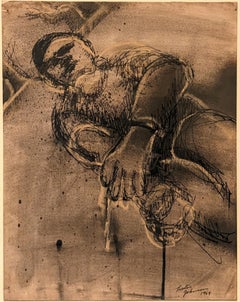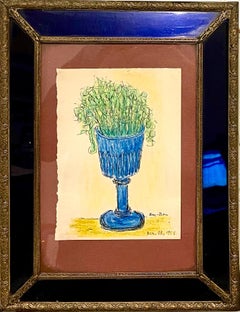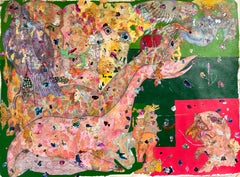Spray Paint Figurative Drawings and Watercolors
to
1
Overall Width
to
Overall Height
to
1
1
14
1
1
1
1
1
1
1
1
1
2,641
129
84
74
59
1
1
1
Style: Expressionist
Medium: Spray Paint
Self Portrait
Located in New York, NY
Lester Johnson Self Portrait 1969 drawn with ink, crayon, and spray enamel on paper. Measuring 14 by 11 inches, this drawing was recently professionally framed.
Category
1960s Expressionist Spray Paint Figurative Drawings and Watercolors
Materials
Enamel
Related Items
Expressionist Color Drawing Cobalt Glass Vintage Frame Modernist Ben Zion WPA
Located in Surfside, FL
Expressionist ink and pastel crayon drawing of flowers in vase.
Framed in a vintage cobalt blue glass original frame
Hand signed and dated
Framed it measures 13.5 X 10.5
The actual ...
Category
1950s Expressionist Spray Paint Figurative Drawings and Watercolors
Materials
Paper, Oil Crayon, Pastel, Ink
$1,250
H 13.5 in W 10.5 in
Drawing, Acrylic, Ink And Colored Pencils On Paper. "Old love, new love"
Located in Bogotá, Bogotá
“Old love, new love” Drawing, acrylic, ink and colored pencils on paper. I developed a drawing technique based on natural pigments from leaves, flowers and bark with which I intend t...
Category
2010s Expressionist Spray Paint Figurative Drawings and Watercolors
Materials
Paper, Ink, Acrylic, Pencil, Color Pencil
German Expressionist Drawing, Watercolor Painting Jules Pascin Cuba Scene 1910
By Jules Pascin
Located in Surfside, FL
Genre: German Expressionist
Subject: Woman, Cuban Scene
Medium: watercolor paint, ink or pencil
Surface: Paper
This is hand signed lower right.
There is an inscription at bottom e...
Category
1910s Expressionist Spray Paint Figurative Drawings and Watercolors
Materials
Paper, Ink, Watercolor
British 20th Century watercolour on paper 'Adam and Eve'
Located in Petworth, West Sussex
Derrick Latimer Sayer (British, 1917 – 1992)
Adam and Eve
Ink and watercolour/ gouache on paper
Signed ‘DEK Sayer 12/44’ (lower right)
13.5/8 x 10.1/2 in. (34.7 x 26.5 cm.)
Sayer st...
Category
20th Century Expressionist Spray Paint Figurative Drawings and Watercolors
Materials
Paper, Ink, Watercolor, Gouache
$964
H 13.63 in W 10.5 in D 1 in
Forgotten Joanna Flatau Contemporary art watercolor woman nude portrait ink
Located in Paris, FR
Watercolor and ink on paper
Unique work
Hand-signed by the artist
Joanna Flatau was born in Varsaw, Poland.
She graduated from Varsaw History of Arts University and from the Fine A...
Category
Early 2000s Expressionist Spray Paint Figurative Drawings and Watercolors
Materials
Paper, Ink, Watercolor
$4,171
H 25.2 in W 17.72 in
The Wine Merchant female figure with large black wine bottles vibrant color
Located in Brooklyn, NY
Soft pastel on toned sanded archival paper suitable for framing under glass.
Signed by artist
ABOUT Stephen Basso
Stephen Basso's highly original pastels and oil paintings are rom...
Category
2010s Expressionist Spray Paint Figurative Drawings and Watercolors
Materials
Pastel, Archival Paper
$950
H 27 in W 19 in D 1 in
Drawing, Pastel, Ink And Colored Pencils. "Free Spirits"
Located in Bogotá, Bogotá
Pastel, Pencil, petal flowers, Color and Ink on Paper.
The base of this drawing is Fabriano paper of 120g /m2. I use natural dyes of flowers, herbs, leaves, bark of trees as the fir...
Category
2010s Expressionist Spray Paint Figurative Drawings and Watercolors
Materials
Paper, Pastel, Ink, Pencil, Color Pencil
Pastel, Ink Drawing Rocks And Cloud Landscape Jewish American Modernist WPA
Located in Surfside, FL
Miniature Landscape
Provenance: Virginia Field, Arts administrator; New York, N.Y. Assistant director for Asia House gallery. (she was friends with John von Wicht and Andy Warhol)
Born in 1897, Ben-Zion Weinman...
Category
Mid-20th Century Expressionist Spray Paint Figurative Drawings and Watercolors
Materials
Pastel, Ink, Watercolor
Violin Player Watercolor
By Chaim Gross
Located in Lake Worth Beach, FL
Violin Player 1960/65
work size 11x29, with frame 18x36 inches, artist signed.
Chaim Gross (1904 Austria–1991 USA) will always be remembered as one of the foremost American artist : ...
Category
1960s Expressionist Spray Paint Figurative Drawings and Watercolors
Materials
Ink, Watercolor, Pen, Archival Paper
Street Life New York - Haunting Faces Windows Expressionism Mid-Century
Located in Miami, FL
Mid-century artist Lawrence Kupferman paints a madly eerie New York street scene. An exaggerated upward view of two 19th-century walk-ups is split by a forced perspective of a downwa...
Category
1940s Expressionist Spray Paint Figurative Drawings and Watercolors
Materials
Paper, Ink, Watercolor, Pen
$12,000
H 24.25 in W 18 in D 1 in
Egg Dancers. Male and Female nude figures black background red tones dark humor
Located in Brooklyn, NY
Mixed media on red toned archival paper signed and dated bottom left.
Part of the artist series of egg walkers/ dancers.
Playful twist on psychological theme
ABOUT Stephen Basso
St...
Category
Early 2000s Expressionist Spray Paint Figurative Drawings and Watercolors
Materials
Pastel, Gouache, Archival Paper
$1,500
H 27 in W 35 in D 1 in
"Untitled" (2023) By Quang Ho, Original Charcoal Illustration
By Quang Ho
Located in Denver, CO
Quang Ho's "Untitled" (2023) is an original handmade charcoal drawing done on paper. This piece depicts an abstracted portrait of nude women.
Artist's Statement
"Realism and abstrac...
Category
20th Century Expressionist Spray Paint Figurative Drawings and Watercolors
Materials
Paper, Pastel
$3,500
H 38.25 in W 48.25 in
Spray Paint figurative drawings and watercolors for sale on 1stDibs.
Find a wide variety of authentic Spray Paint figurative drawings and watercolors available on 1stDibs. While artists have worked in this medium across a range of time periods, art made with this material during the 21st Century is especially popular. There are many well-known artists whose body of work includes ceramic sculptures. Popular artists on 1stDibs associated with pieces like this include Raluca Arnăutu, Lester Johnson, Petrus Amuthenu, and (André) André Saraiva. Frequently made by artists working in the Contemporary, Expressionist, all of these pieces for sale are unique and many will draw the attention of guests in your home. Not every interior allows for large Spray Paint figurative drawings and watercolors, so small editions measuring 0.1 inches across are also available Prices for figurative drawings and watercolors made by famous or emerging artists can differ depending on medium, time period and other attributes. On 1stDibs, the price for these items starts at $11 and tops out at $1,595,000, while the average work can sell for $700.
Recently Viewed
View AllMore Ways To Browse
Carol Young Barn
Cavalier Dog Painting
Charles Bronson
Charles Culver Paintings
Clair De Lune Paintings
Constantinople Landscape Painting
David Weeks Chandelier
E Fletcher
Elizabeth Chalmers
Elizabeth Wilcox
Fat Lady Vintage
Frank Heath
Frederick Richard Lee
Henry Rogers
Sandy Hook Painting
Stuyvesant Van Veen
Summer J Hart
Terriers Ratting Painting


